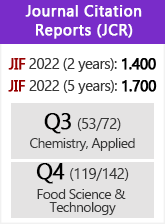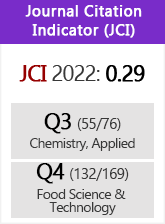Chemical composition and oxidative evolution of Sacha Inchi (Plukentia volubilis L.) oil from Xishuangbanna (China)
DOI:
https://doi.org/10.3989/gya.075713Keywords:
Antioxidant capacity, Chemical composition, Omega–3, Physicochemical characteristics, Sacha Inchi, Storage stabilityAbstract
Sacha Inchi oil was studied for its physicochemical characteristics, chemical composition, radical scavenging activity and storage stability. The fatty acid composition was studied by gas chromatography–flame ionization (GC–FID) and the analysis showed that the oil is highly enriched in α–linolenic (43.5%) and linoleic (39.6%) acids. The tocopherol content in the oil analyzed by high performance liquid chromatography/ultraviolet– visible detector (HPLC/UV–VIS) was also high (161.87 mg.100 g-1). Both DPPH and ABTS assays detected relatively high radical scavenging activity. After twelve months of storage, the oil showed relatively good storage stability. The results will help guide further investigation of the health benefits of Sacha Inchi oil for the population and the development of better edible oil products and nutraceuticals.
Downloads
References
AOCS. 2009. Official methods and recommended practices of the AOCS (6th ed.). Champaign, IL, USA.
Cao M, Zou XM, Warren M, Zhu H. 2006. Tropical Forests of Xishuangbanna, China. Biotropica 38, 306–309. http://dx.doi.org/10.1111/j.1744-7429.2006.00146.x
Cai ZQ, Jiao DY, Tang SX, Dao XS, Lei YB, Cai CT. 2012. Leaf photosynthesis, growth, and seed chemicals of Sacha Inchi plants cultivated along an altitude gradient. Crop Sci. 52, 1859–1867. http://dx.doi.org/10.2135/cropsci2011.10.0571
Cai ZQ, Yang Q, Tang SX, Dao XS. 2011. Nutritional evaluation in seeds of woody oil crop Plukenetia volubilis Linneo. Acta Nutrimenta Sinica. 33, 193–195.
Christie WW. 2003. Isolation, Separation, Identification and Structural Analysis of Lipids. The Oily Press. Bridgwater, England.
Do Prado IM, Giufrida WM, Alvarez VH, Cabral VF, Quispe–Condori S, Saldana MDA, Cardozo L. 2011. Phase equilibrium measurements of Sacha Inchi oil (Plukenetia volubilis) and CO2 at high pressures. J. Am. Oil. Chem. Soc. 88, 1263–1269. http://dx.doi.org/10.1007/s11746-011-1786-z
Dyer JM, Stymne S, Green AG, Carlsson AS. 2008. High–value oils from plants. Plant J. 54, 640–655. http://dx.doi.org/10.1111/j.1365-313X.2008.03430.x
Espin JC, Soler–Rivas C, Wichers HJ. 2000. Characterization of the total free radical scavenger capacity of vegetable oils and oil fractions using 2, 2–diphellyl–1–picrylhydrazyl radical. J. Agric. Food. Chem. 48, 648–656. http://dx.doi.org/10.1021/jf9908188
Fanali C, Dugo L, Cacciola F, Beccaria M, Grasso S, Dacha M, Dugo P, Mondello L. 2011. Chemical characterization of Sacha Inchi (Plukenetia volubilis L.) Oil. J. Agric. Food. Chem. 59, 13043–13049. http://dx.doi.org/10.1021/jf203184y
FAO/WHO 1999. The Codex Alimentarius Commission. Codex standard for named vegetable oils. Available from: http://www.codexalimentarius.org/ (Last visited 1st March 2013).
Fereidoon S. 2005. Quality assurance of fats and oils. In Fereidoon Shahidi, Bailey's Industrial Oil and Fat Products (6th ed.) (pp. 565–575). John Wiley & Sons Inc. Manhattan, USA.
Gimeno E, Calero E, Castellote A, Lamuela–Raventos RM, de la Torre MC, Lopez–Sabater MC. 2000. Simultaneous determination of alpha–tocopherol and beta–carotene in olive oil by reversed–phase high–performance liquid chromatography. J. Chromatogr. A. 881, 255–259. http://dx.doi.org/10.1016/S0021-9673(00)00272-7
Gliszczyn’ska–S’wigło A, Sikorska E. 2004. Simple reversed–phase liquid chromatography method for determination of tocopherols in edible plant oils. J. Chromatogr. A. 1048, 195–198. http://dx.doi.org/10.1016/j.chroma.2004.07.051
Guillén MD, Ruiz A, Cabo N, Chirinos R, Pascual G. 2003. Characterization of Sacha Inchi (Plukenetia volubilis L.) oil by FTIR spectroscopy and H–1 NMR. comparison with linseed oil. J. Am. Oil. Chem. Soc. 80, 755–762. http://dx.doi.org/10.1007/s11746-003-0768-z
Gutiérrez LF, Rosada LM, Jiménez Á. 2011. Chemical composition of Sacha Inchi (Plukenetia volubilis L.) seeds and characteristics of their lipid fraction. Grasas Aceites 62, 76–83. http://dx.doi.org/10.3989/gya044510
Hamaker BR, Valles C, Gilman R, Hardmeier RM, Clark D, Garcia HH, Gonzales AE, Kohlstad I, Castro M, Valdivia R, Rodriguez T, Lescano M. 1992. Anino–acid and fatty–acid profiles of the Incha peanut (Plukenetia volubilis). Cereal Chem. 69, 461–463.
Hrncirik K, Fritsche S. 2004. Comparability and reliability of different techniques for the determination of phenolic compounds in virgin olive. Eur. J. Lipid. Sci. Technol. 106, 540–549. http://dx.doi.org/10.1002/ejlt.200400942
Jimenez–Escrig A, Dragsted LO, Daneshvar B, Pulido R, Saura–Calixto F. 2003. In vitro antioxidant activities of edible artichoke (Cynara scolymus L) and effect on biomarkers of antioxidants in rats. J. Agric. Food Chem. 51, 5540–5545. http://dx.doi.org/10.1021/jf030047e
Krivankova B, Polesny Z, Lojka B, Lojkova J, Banout J, Preininger D. 2007. Sacha Inchi (Plukenetia volubilis, Euphorbiaceae): a promising oilseed crop from Peruvian Amazon. In Conference on International Agricultural Research and Development. University of Kassel, Germany.
Luaces P, Romero C, Gutierrez F, Sanz C, Perez AG. 2007. Contribution of olive seed to the phenolic profile and related quality parameters of virgin olive oil. J. Sci. Food Agric. 87, 2721–2727. http://dx.doi.org/10.1002/jsfa.3049
Makinen M, Kamal–Eldin A, Lampi AM, Hopia A. 2000. Effects of alpha– and gamma–tocopherols on formation of hydroperoxides and two decomposition products from methyl linoleate. J. Am. Oil. Chem. Soc. 77, 801–806. http://dx.doi.org/10.1007/s11746-000-0128-z
Maurer NE, Hatta–Sakoda B, Pascual–Chagman G, Rodriguez–Saona LE. 2012. Characterization and authentication of a novel vegetable source of omega–3 fatty acids, Sacha Inchi (Plukenetia volubilis L.) oil. Food Chem. 134, 1173–1180. http://dx.doi.org/10.1016/j.foodchem.2012.02.143
Minioti KS, Georgiou CA. 2010. Comparison of different tests used in mapping the Greek virgin olive oil production for the determination of its total antioxidant capacity. Grasas Aceites 61, 45–51. http://dx.doi.org/10.3989/gya.010508
Morales FJ, Jiménez–Pérez S. 2001. Free radical scavenging capacity of Maillard reaction products as related to colour and fluorescence. Food Chem. 72, 119–125. http://dx.doi.org/10.1016/S0308-8146(00)00239-9
Myers N, Mittermeier RA, Mittermeier CG, da Fonseca GAB, Kent J. 2000. Biodiversity hotspots for conservation priorities. Nature 403, 853–858. http://dx.doi.org/10.1038/35002501
Ni–Eidhin D, Burke J, O'Beirne D. 2003. Oxidative stability of omega–3 rich camelina oil and camelina oil–based spread compared with plant and fish oils and sunflower spread. J. Food Sci. 68, 345–353. http://dx.doi.org/10.1111/j.1365-2621.2003.tb14163.x
Ozcan MM. 2010. Some nutritional characteristics of kernel and oil of peanut (Arachis hypogaea L.). J. Oleo Sci. 59, 1–5. http://dx.doi.org/10.5650/jos.59.1
Pietrowski BN, Tahergorabi R, Matak KE, Tou JC, Jaczynski J. 2011. Chemical properties of surimi sea food nutrified with omega–3 rich oils. Food Chem. 129, 912–919. http://dx.doi.org/10.1016/j.foodchem.2011.05.044
Procida G, Stancher B, Cateni F, Zacchigna M. 2013. Chemical composition and functional characterisation of commercial pumpkin seed oil. J. Sci. Food Agric. 93, 1035–1041. http://dx.doi.org/10.1002/jsfa.5843
Rymer C, Givens DI. 2005. n–3 fatty acid enrichment of edible tissue of poultry: A review. Lipids 40, 121–130. http://dx.doi.org/10.1007/s11745-005-1366-4
Rubio–Rodriguez N, Beltran S, Jaime IM, de Diego S, Sanz MT, Carallido JR. 2010. Production of omega-3 polyunsaturated fatty acid concentrates: A review. Innov. Food Sci. Emerg. 11, 1–12. http://dx.doi.org/10.1016/j.ifset.2009.10.006
Semino CA, Rojas FC, Zapata ES. 2008. Protocolo del cultivo de Sacha Inchi. (Plukenetia volubilis L.). La Merced, Peru.
Stark C, McNeil DL, Savage GP. 2000. The effect of storage conditions on the stability of peroxide values of New Zealandgrown walnuts. P. Nutr. Soc. N. 25, 43–54.
Valavanidis A, Nisiotou C, Papageorgiou Y, Kremli I, Satravelas N, Zinieris N, Zygalaki H. 2004. Comparison of the radical scavenging potential of polar and lipidic fractions of olive oil and other vegetable oils under normal conditions and after thermal treatment. J. Agric. Food Chem. 52, 2358–2365. http://dx.doi.org/10.1021/jf030491h
Venegas–Calderón M, Sayanova O, Napier JA. 2010. An alternative to fish oils: Metabolic engineering of oil seed crops to produce omega–3 long chain polyunsaturated fatty acids. Prog. Lipid Res. 49, 108–119. http://dx.doi.org/10.1016/j.plipres.2009.10.001
Zhang J, Wang CR, Gao JQ, Li XW, Chen JS. 2004. Study on dietary lipid intakes in Chinese residents. Acta Nutrmenta Sinica 26, 167–171.
Published
How to Cite
Issue
Section
License
Copyright (c) 2014 Consejo Superior de Investigaciones Científicas (CSIC)

This work is licensed under a Creative Commons Attribution 4.0 International License.
© CSIC. Manuscripts published in both the printed and online versions of this Journal are the property of Consejo Superior de Investigaciones Científicas, and quoting this source is a requirement for any partial or full reproduction.All contents of this electronic edition, except where otherwise noted, are distributed under a “Creative Commons Attribution 4.0 International” (CC BY 4.0) License. You may read here the basic information and the legal text of the license. The indication of the CC BY 4.0 License must be expressly stated in this way when necessary.
Self-archiving in repositories, personal webpages or similar, of any version other than the published by the Editor, is not allowed.
















